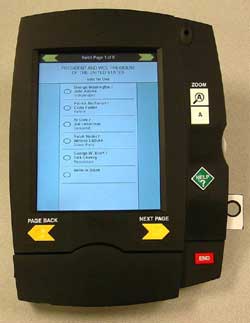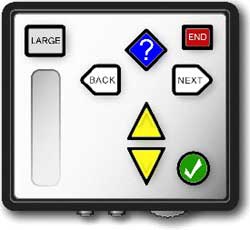Extended Usability versus Accessibility in Voting Systems
ABSTRACT
Increased focus is being placed on the accessibility of voting systems by people who have disabilities. The common approach for this has been to require that at least one voting system in each location be accessible to people with disabilities. However, work with individuals who are older, and who need to have accommodations to allow them to vote confidently and accurately, suggests that they may not recognize their need or choose not to use accessible voting booths. As a result the concept of “extended usability” is advanced to accommodate these individuals. “Extended usability” on mainstream voting machines would be combined with “special accessible” station(s) (or accessories) for those who cannot be accommodated via extended usability due to the need for special interface devices.
Keywords:
usability; voting; universal design; access; disability
INTRODUCTION
There has been a growing movement toward ensuring the civil rights of individuals with disabilities in recent years, including the passage of the Americans with Disabilities Act in 1990. The most recent example is the disability access provisions in the Helping America Vote Act (HAVA) this past year. The approach taken in the act was to ensure that there was at least one voting booth in each station that was accessible. This is similar to the model used in restrooms and other locations and in a related fashion to parking, etc. However, this approach overlooks one very important factor. A large percentage of individuals who acquire disabilities, acquire them as they age [1]. (See figure 1). These individuals incur a high percentage of visual, hearing and physical disabilities. For example, 34% of people 70-84 have visual disabilities and this percentage jumps to 63% for those 85 and up [2]. The greatest problem however stems from the fact that individuals of this age often do not realize they have a disability or do not admit that they have a disability to themselves or to others.
![Figure 1 shows disability as a function of aging. U.S. Census Bureau [1]. Figure 1 contains five pie charts showing the increase in disability with aging.](Images/Vanderheiden/Fig1Thumb.jpg) |
|---|
As a result, many individuals who are older may be experiencing difficulty in voting accurately, but will not identify themselves as having such a problem when voting. Often they know poll workers or meet people they know at the voting place. Also, their disability may be such that their reading is marginal and, rather than embarrassing themselves, they will attempt to vote in a straightforward fashion. The result can be anything from misreading the ballot to having so much difficulty that they skip voting in many races to having mis-votes, under-votes or over-votes due to not marking the ballot accurately.
INITIAL HYPOTHESIS
 |
|---|
We began this work with the hypothesis that a single voting station could be designed that would be accessible to everyone. After working through a number of design iterations and trials, we came up with the system shown in Figure 2. This system allowed individuals to either vote by using the touch screen or the buttons below. For individuals who could not read the 14 point text on the display, a zoom function was provided that could increase the text size onscreen from its standard 14 point size up to 30 point text. Operation was made straightforward by using a simple paper ballot as a metaphor. Each race was on a separate “page” and large, arrow shaped buttons were used to turn the pages. To vote the person simply touches a name and it is marked.
If the person had difficulty in seeing, reading or using the touch screen, they could use the buttons below the screen to move up and down through the candidates having them read aloud through headphones. The prototype was constructed and tested with older individuals at an elder living facility and at a senior center.
 |
|---|
RESULTS
The results showed that although individuals were physically and visually able to vote, the visual complexity and the more complex instructions of the system were a problem for them. Given that these were the individuals who volunteered to participate (and not elders who were afraid to use technology), this was a problem.
Extended Usability
Based on this testing, it was clear that our attempt to accommodate everyone on a single voting system resulted in making it more complex than optimal – or acceptable. Although this might not be a problem on personal devices (where people have a chance to become familiar with them) it was not satisfactory for voting systems for a number of reasons. First, many people who were voting would be faced with the device for the first time, yet would be required to perform successfully, while unsupervised and untrained. There would be no learning period, and the time between voting experiences is sufficiently long that any year-to-year learning would fade, especially for older voters. Secondly and very importantly, most pieces of technology (e.g. cell phones) are purchased by individuals who have decided that they want to use the technology. People who are completely technology averse will generally avoid all devices. In a voting situation however, the individuals who would ordinarily avoid all technology would be confronted with the voting device and must use it (or not vote).
 |
|---|
We therefore began trying to identify aspects that could be retained in the “mainstream” voting system without creating complexity. The goal now was to require as few people as possible to use a “special voting station”, and, to maximize the number of older people with functional limitations that could use the mainstream voting system. We also paid attention to the cost of the mainstream stations. The result of this was the system shown in Figure 3a. However, we introduced a new touch and read feature. This system also removed all of the extra controls and assumed the individual could use a touch screen. It retained the voice output and zoom capabilities. It maintained the simple one race per page and dedicated page turning button to make it as easy as possible for individuals who are not familiar with computers to be able to turn the pages and vote.
By maintaining the voice functionality in this version, it is possible to accommodate not only individuals with low vision, but a large percentage of individuals who are legally blind. Even individuals who cannot read large text when held closely can view the ballot and see where the candidates' names are located. By touching each candidates name in turn, they can hear it read to them. They can thus, explore the candidates, locate the candidates they desire, and then touch the checkbox next to the name to cause it to be marked (and read again in confirmation). In this fashion, individuals who would not ordinarily be able to use the touch screen voting system would be able to use this “extended usability” system. This would include individuals who are older; who have low vision; who left their reading glasses at home; who are legally blind but can still see where names are (but not read them accurately); who cannot read (for whatever reason); who do not recognize ethnic names when printed; for whom English is a second language, and; who might misread a name but would catch it if read aloud immediately upon selection.
This then left a much smaller group (in the range of perhaps 1%) of the population who could not use this device because they could not use a touch screen even if it did not require reading. This would include individuals with severely limited range of motion, individuals who had no vision at all, and individuals who must use personal interfaces such as head operated switches. To accommodate these users, a “special input” module would be used in conjunction with the “mainstream” tablet. See Figure 3b. It could either be attached to one of the voting stations or it could be available to be connected to any of the voting stations. It would connect to the main voting station using a thin secure serial connection from with it would also draw its power. Individuals who could not reach the touchscreen could place this in their lap. It has highly tactile buttons so it could be used by individuals who are blind and special switches could be inserted into to it to allow it to be used with alternate switches. It contains all of the buttons needed to vote, including the ability to turn pages, move up and down through the choices, select them, and confirm their vote at the end. The help key and volume key are also duplicated as well as a zoom button for those who can see but not reach the main voting station.
DISCUSSION
The result is an approach we term extended usability which basically involves enhancing the usability of the standard voting platform so that many individuals, including many with emerging disabilities (which they do not recognize and/or acknowledge) are able to vote confidently and accurately. By adding the voice confirmation to the normal visual confirmation and the review of the votes cast at the end, as well as careful implemented warnings for under- and over-votes, people are provided with the feedback needed to confidently and accurately vote. It also provides a mechanism to accommodate those individuals who need special input adaptations, but it greatly minimizes the number of individuals who need to have “something special” in order to vote. It also provides a mechanism for them to vote at “standard” stations using their adaptations.
REFERENCES
- U.S. Census Bureau Report on Americans with Disabilities: 1994-1995, P70-61 (August 1997). Based on survey of income and program participation: Oct. 1994 – Jan. 1995.
- Survey: National Health Interview Surveys, 1983-1985: tabulations from public use tapes.
ACKNOWLEDGEMENT
This work was (is) primarily funded by the National Institute on Disability and Rehabilitation Research (NIDRR) through the U.S. Dept. of Education, grant numbers H133E030012 & H133E980008. The opinions expressed here do not necessarily represent the policy of the U.S. Dept. of Education.
CONTACT
Gregg Vanderheiden, Ph.D.
gv@trace.wisc.edu ,
Trace Research and Development Center
2107 Engineering Centers Bldg,
1550
Engineering Drive, Madison, WI 53706,
(608) 262-6966
